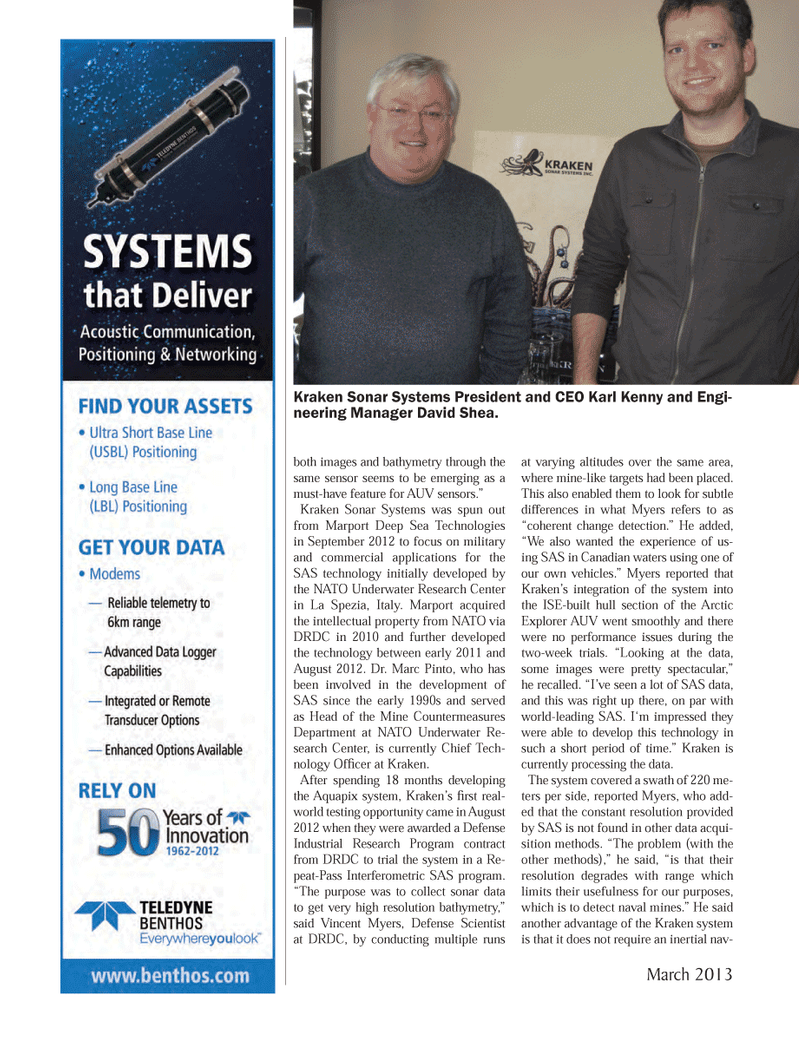
Page 58: of Marine Technology Magazine (March 2013)
Instrumentation: Measurement, Processing & Analysis
Read this page in Pdf, Flash or Html5 edition of March 2013 Marine Technology Magazine
both images and bathymetry through the same sensor seems to be emerging as a must-have feature for AUV sensors.? Kraken Sonar Systems was spun out from Marport Deep Sea Technologies in September 2012 to focus on military and commercial applications for the SAS technology initially developed by the NATO Underwater Research Center in La Spezia, Italy. Marport acquired the intellectual property from NATO via DRDC in 2010 and further developed the technology between early 2011 and August 2012. Dr. Marc Pinto, who has been involved in the development of SAS since the early 1990s and served as Head of the Mine Countermeasures Department at NATO Underwater Re- search Center, is currently Chief Tech- nology Of cer at Kraken. After spending 18 months developing the Aquapix system, Kraken?s rst real- world testing opportunity came in August 2012 when they were awarded a Defense Industrial Research Program contract from DRDC to trial the system in a Re-peat-Pass Interferometric SAS program. ?The purpose was to collect sonar data to get very high resolution bathymetry,? said Vincent Myers, Defense Scientist at DRDC, by conducting multiple runs at varying altitudes over the same area, where mine-like targets had been placed. This also enabled them to look for subtle differences in what Myers refers to as ?coherent change detection.? He added, ?We also wanted the experience of us- ing SAS in Canadian waters using one of our own vehicles.? Myers reported that Kraken?s integration of the system into the ISE-built hull section of the Arctic Explorer AUV went smoothly and there were no performance issues during the two-week trials. ?Looking at the data, some images were pretty spectacular,? he recalled. ?I?ve seen a lot of SAS data, and this was right up there, on par with world-leading SAS. I?m impressed they were able to develop this technology in such a short period of time.? Kraken is currently processing the data. The system covered a swath of 220 me- ters per side, reported Myers, who add-ed that the constant resolution provided by SAS is not found in other data acqui-sition methods. ?The problem (with the other methods),? he said, ?is that their resolution degrades with range which limits their usefulness for our purposes, which is to detect naval mines.? He said another advantage of the Kraken system is that it does not require an inertial nav- Kraken Sonar Systems President and CEO Karl Kenny and Engi- neering Manager David Shea. March 2013 MTR #2 (50-65).indd 58MTR #2 (50-65).indd 583/6/2013 1:48:33 PM3/6/2013 1:48:33 PM

 57
57

 59
59
